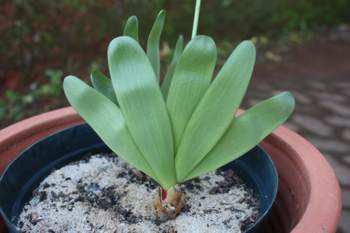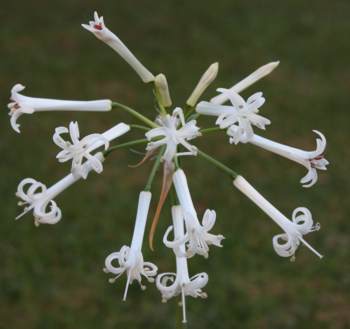Strumaria phonolithica
Strumaria phonolithica Dinter
Family: Amaryllidaceae
Common names: none known
Introduction
Strumaria phonolithica is a rare and interesting autumn- and early winter-flowering bulb endemic to southwestern Namibia. Its ornamental leaf fans and slightly sweet-scented white or light pink flowers make it a desirable subject for growers of unusual bulbous plants.

Description
Description
This winter-growing, summer-dormant plant grows 150-190 mm high and has a round, solitary bulb with a distinct neck covered with thick layers of hard papery outer tunics. The plant produces an erect fan of 3-4 light green, strap-shaped leaves (up to six in cultivation) with blunt tips that emerge simultaneously with a brownish green, suberect flower stem.

The flower head produces 3-6 narrowly funnel-shaped, symmetrical flowers (up to 14 in cultivation) which are white or light pink and slightly sweet-scented with long, sharply recurved tepals . The stamens protrude slightly beyond the tepals and the anthers are maroon prior to opening and produce cream pollen. The style protrudes prominently and the fruit is a rounded, thin-walled capsule which disintegrates rapidly as the round, green or dull red fleshy seeds enlarge. Flowering takes place in May and early June.

Conservation Status
Status
Strumaria phonolithica is a protected species. In a recent conservation assessment (2005) it was concluded to be under no apparent threat and the populations appear to be stable, but as it is only known from a few locations, its conservation status is categorised as Rare.
Distribution and habitat
Distribution description
Strumaria phonolithica is endemic to the Aurus and Klinghardt mountains in the southwestern part of Namibia. It grows in colonies in Desert and Succulent Steppe vegetation in association with dwarf succulents and its niches are ledges of steep south-facing mountain slopes in porous, loose phonolite gravel, and in pockets of sandstone rocky outcrops. Occurring in arid terrain with highly erratic rainfall, the bulbs are dependent on dew and frequent winter sea fogs which provide sufficient moisture for the shallow roots to absorb. The plants occur in clumps but the bulbs are solitary and do not form offsets. The clumping effect is the result of seeds that have germinated close together.
Derivation of name and historical aspects
History
The German botanical collector Moritz Kurt Dinter (1868-1945) discovered this rare and intriguing plant in the Klinghardt Mountains in southwestern Namibia in August 1922 and cultivated it there at the farm `Lichtenstein' in central Namibia, where it flowered in May 1923. In the same year, he described and published it in a contribution on Namibian plants in Feddes Repertorium, a German journal of botanical taxonomy. The genus Strumaria was established by Baron Nicolaus Joseph von Jacquin in 1797 and is derived from the Latin struma, which refers to the swollen base of the style in some species. The specific name phonolithica is derived from Greek and is descriptive of the volcanic grey phonolite rock plates amongst which this species has been found, which produce a distinctive metallic sound when knocked. Strumaria gigantea is a synonym of S. phonolithica.
The genus Strumaria has 28 species and is endemic mainly to the winter rainfall zone of southwestern and southern Namibia, the Northern, Western and Eastern Cape provinces in South Africa, and also occurs in summer rainfall parts of the eastern Free State Province and western Lesotho. Its main centres of diversity are in central Namaqualand around Springbok, and on the Bokkeveld Escarpment near Nieuwoudtville. Flowering takes place mainly in autumn and early winter and one of the best-known species is S. truncata, which usually produces pendent flower clusters atop a slender flower stem and has a striking deep reddish maroon aerial sheath which supports the base of the leaves. Strumaria phonolithica and the white-flowered S. barbarae from southwestern Namibia and the northeastern Richtersveld have the longest flowers in the genus, both reaching up to 38mm.

Ecology
Ecology
The bulbs commence active growth in early autumn with the production of a new set of roots. This is followed by the leaves and flowers which usually appear simultaneously. The slightly sweet-scented flowers contain nectar in their bases but it is not precisely known what pollinates them. The seed capsules disintegrate and the fleshy seeds drop to the ground from mid- to late June, germinating immediately. The leaves turn yellow in late spring and the bulbs undergo a dormant period of over six months from early summer to early autumn.
Uses
Use
Strumaria phonolithica has no medicinal or magical uses. In ornamental horticulture, it is used to a limited extent by specialist bulb growers as a container plant.
Growing Strumaria phonolithica
Grow
For the specialist bulb grower, Strumaria phonolithica is worth growing for its ornamental leaf fans, scented white, pendent flowers and exposed bulb neck covered with thick layers of papery outer tunics. It is easily grown with careful attention to aspect and watering procedure and very well suited to containers, but cannot survive the rigours of general garden cultivation.
Compared with other members of this genus, S. phonolithica produces its leaves and flowers relatively late in the season, in late autumn. Flowering is fairly consistent in cultivation, although mature bulbs sometimes skip flowering for one or two seasons.
The plants perform well in 200mm diameter plastic pots in a sharply drained, sandy growing medium consisting of equal parts of washed coarse river sand or grit, and industrial (silica) sand. The bulbs like a position receiving bright light throughout the day, or morning sun and afternoon shade and are planted in early autumn with the upper part of the neck exposed. As with all strumarias, this species has deciduous roots and produces a new set each autumn. The roots and bulbs are sensitive to excess moisture and following an initial drench in autumn, require drenching at well-spaced intervals of about two weeks, once the leaves have started to emerge. It is important for the growing medium to desiccate sufficiently before the next drench is given, and once the leaves start to turn yellow in spring, watering must be withheld completely until the following autumn.
The plants are generally best regarded as half hardy (can tolerate minimum temperature down to 0°C but can probably withstand very light frost for a few hours. They require the protection of the cool glasshouse in cold climates.
The only feasible way in which to propagate this species is by means of seed as the bulbs are solitary and do not form offsets. Seed production in cultivation is erratic and propagation by this method is a long process, taking a minimum of five or six years before flowering stage is reached, in ideal conditions. Harvest the fleshy round seeds as soon as they are easily detached from the capsules and sow in deep pots by scattering them onto a sowing medium such as equal parts of washed coarse river sand or grit, and industrial (silica) sand. Lightly cover the seeds with a 2mm layer of the same medium and water well with a fine rose once per week.
The bulb tunics and leaf bases of Strumaria phonolithica and all members of this genus are susceptible to infestations of mealy bug.
References
- Dinter, M.K. 1923. Beiträge zur Flora von Südwestafrika II. Feddes Repertorium 19: 177-186.
- Duncan, G.D. 2010. Grow bulbs . Kirstenbosch Gardening Series. South African National Biodiversity Institute, Cape Town.
- Duncan, G.D. 2013. Strumaria phonolithica . Curtis's Botanical Magazine 30(2): 87-94.
- Du Plessis, N.M. & Duncan, G.D. 1989. Bulbous plants of southern Africa . Tafelberg, Cape Town.
- Loots, S. 2005. Strumaria phonolithica . Red Data Book of Namibian Plants . Southern African Botanical Diversity Network Report No. 38. Sabonet, Pretoria and Windhoek.
- Snijman, D.A. 1994. Systematics of Hessea, Strumaria and Carpolyza (Amaryllideae: Amaryllidaceae). Contributions from the Bolus Herbarium 16: 1-162.
- Snijman, D.A. 2005. Three new species and a new synonym in Strumaria (Amaryllideae: Amaryllidaceae) from southern Africa. Bothalia 35(1): 21-27.
Credits
Graham Duncan
Kirstenbosch National Botanical Garden
July 2014
Plant Attributes:
Plant Type: Bulb
SA Distribution:
Soil type: Sandy
Flowering season: Autumn, Winter
PH: Acid, Neutral
Flower colour: White, Pink
Aspect: Full Sun
Gardening skill: Challenging
Special Features:
Horticultural zones







Rate this article
Article well written and informative
Rate this plant
Is this an interesting plant?
Login to add your Comment
Back to topNot registered yet? Click here to register.